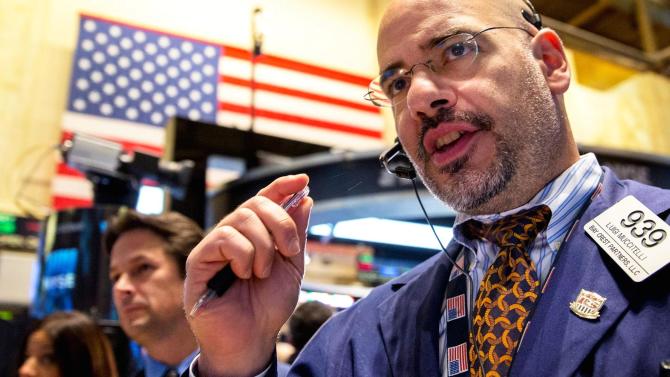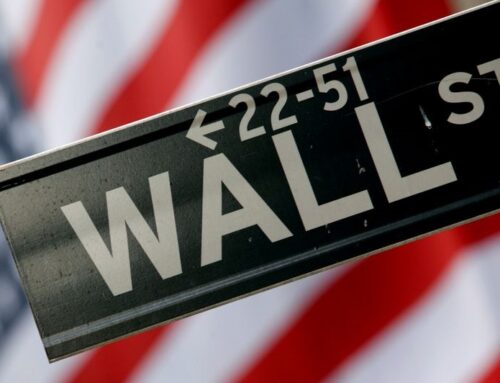U.S. Stocks Stabilize After Sharp Selloff
March 11, 2015
U.S. stocks closed mildly lower on Wednesday as equities failed to recover from Tuesday’s selloff, amid continued concern over dollar gains and the timing of a Fed interest rate hike.
It’s “fear of what negative impact the strong dollar has without thinking of positives,” said Art Hogan, chief market strategist at Wunderlich Securities.
The U.S. dollar extended gains to rise more than 1 percent, a 12-year high.
Historical analysis by Wunderlich showed that the S&P 500 was down for 19 of the last 27 trading days during which the dollar was strong. Before that, the index and the dollar had no correlation.
“This suggests the market has started pricing in a negative affect on the U.S. economy,” said Athanasios Vamvakidis, head of G10 FX strategy in Europe for Bank of America Merrill Lynch. With the dollar’s “pace of acceleration, there is a risk that further dollar strength could impact the U.S. market,”
Driving the dollar’s rise was the euro(Exchange:EUR=)‘s continued decline, falling below $1.06 on Wednesday to a 12-year low. Bets are on as to when the euro could reach parity against the greenback (Exchange:USD=), with the currency under pressure as the European Central Bank’s quantitative easing program kicked off this week.
Read More Dollar-euro parity: What a one-to-one exchange means
“It’s not logical long term to assume that a strong dollar is a negative,” said Maris Ogg, president of Tower Bridge Advisors. “It draws capital to the U.S.”
“In the long run, lower oil prices and a strong dollar are good,” she said.
The Dow Transports closed up 1.12 percent as oil prices continued to edge lower. Joe Terranova, a trader on CNBC’s “ Halftime Report ” Model Portfolio competition, bought an airline stock on the energy decline Wednesday.
Transports benefit from continued low oil prices because “even if prices do their normal seasonal run, it’s going to be cheaper than a year ago,” said Phil Flynn, energy market analyst at Price Futures Group.
Oil futures extended losses on Wednesday after government data showed U.S. commercial crude inventories rose by 4.5 million barrels last week, well above an industry group report released on Tuesday.
Crude oil futures settled down 12 cents at $48.17 a barrel on the New York Mercantile Exchange, the lowest since Feb. 26. Oil touched a one-month low of $47.33 immediately following the inventory report.
Read More Fed fear factor could keep markets turbulent
Equities dipped in and out of negative territory before closing lower.
“When you have a market entirely driven by news and data you’re going to have … more intraday volatility,” said JJ Kinahan, chief derivatives strategist at TD Ameritrade.”We’re not growing at the pace that everyone is expecting it to grow and that puts the Fed in a tough situation.”
Among the many reports on the Federal Reserve’s expected action, analysts eyed a Wednesday article by the Wall Street Journal that said the Fed would drop “patient” from its statement ahead of a rate hike as early as June.
“The Fed is not tightening, just backing away from its easing program,” Ogg said. She noted that in these transitional periods “the market does OK, in fact, does well.”
U.S. stocks closed more than 1.5 percent lower on Tuesday, with the Dow off more than 300 points and the S&P below 2,050 to wipe out gains for the year. Only the Nasdaq held on to gains of about 2.6 percent for the year.
“Based on the indicators, it seems possible this week could bring a moderately bullish bounce early on, followed by a moderately bearish decline overall later in the week,” Randy Frederick, managing director of trading and derivatives at Charles Schwab, said in a note. “There could also be a bit of a pickup in volatility, so traders should be watchful and maintain their hedges while watching for any buying opportunities that may arise.”
The CBOE Volatility Index (VIX) (^VIX), widely considered the best gauge of fear in the market, traded higher near 17.
“Volatility is picking up so it’s all going to happen quickly,” said Marc Chaikin, CEO of Chaikin Analytics. He sees the possibility of a 5 to 8 percent correction, especially as more stocks make new lows than highs.
The volatility index has traded in a lower range despite analyst expectations for levels of 19 or 20.
With the S&P 500 breaking the support level of 2,085 to 2,093, S&P Capital IQ U.S. Equity Strategist Sam Stovall said in a note that the breach “targets a likely test of the 2,034-55 zone” and “should attract buying interest such that the S&P 500 moves swiftly back above the 2,085-93 area.
“An S&P 500 break below 2,034 along with a VIX move above 20 would be additionally bearish,” he added.
Weekly mortgage applications dropped as rates jumped , with the 1.3 percent decline driven mostly by a 3 percent drop in refinance applications, which makes up 60 percent of all applications. That volume was 80 percent in recent years.
The Treasury Department auctioned $21 billion of 10-year notes at a high yield of 2.13 percent. The bid-to-cover ratio, an indicator of demand, was the highest since December at 2.65.
In the hours following the auction, the yield fell to 2.10 percent, below the key 2.28 percent level some analysts are watching for.
“I won’t say the risk-off trade is ended, but people don’t need the run to fixed income trade as much,” Kinahan said.
Later in the day, the Fed will publish further stress test results for large U.S. banks, assessing their capital plans.
European equities rebounded on Wednesday, with gains for all major bourses except Greece’s. Traders will watch continued debt negotiations between Greece’s newly installed left-wing government and the “troika” of international institutions supervising its bailout program.
Read More Draghi: ECB QE risks are contained
“We’re very concerned about the European situation,” said Pete Benson, co-founder of Beacon Capital Management. “There are some situations that are going to move the market significantly that keep getting kicked down the road.”
With the impending June meeting on Greek debt and the possibility of a U.S. interest rate hike then, “it could all culminate in a very stormy summer,” he said.
In corporate news, Endo International (ENDP) confirmed that it submitted a proposal to the Board of Directors of Salix to acquire all the outstanding shares of common stock of Salix Pharmaceuticals(SLXP) for $175 a share in cash and stock . The proposal competes with Valeant (Toronto Stock Exchange: VRX-CA)‘s $10 billion offer for Salix.
After the close on Wednesday, Skyworks Solutions (SWKS) is scheduled to replace PetSmart(PETM) in the S&P 500. The pet supplies retailer will go private through an acquisition by BC Partners.
“The power gauge rating (on Skyworks) has turned neutral because the valuations are now sky-high,” Chaikin said. Still, “the company is well-positioned in the industry because of the Internet of Things. It’s operating on all four cylinders. There’s only positive things to say.”
Lumber Liquidators (LL), which was battered by a “60 Minutes” report on the safety of its flooring products, continues to trade in volatile pattern, and surged 14 percent on Wednesday.The volatility has been driven by strong opinions-both positive and negative-on the future of the company.
Read More Lumber Liquidators spikes on activist’s long bet
Shake Shack (SHAK) is following up a five percent Tuesday gain with a 1.5 percent decline, ahead of its quarterly earnings report after today’s closing bell.
Krispy Kreme Doughnuts (KKD) will also post earnings.
Goldman Sachs added SanDisk (SNDK) to its “conviction buy” list, citing an attractive valuation and expanding gross margins, among other factors. The memory card maker rose more than 4 percent.
Read More Early movers: EXPR, LL, AAPL, SNDK, GNC & more
The Dow Jones Industrial Average (Dow Jones Global Indexes: .DJI) closed down 27.55 points, or 0.16 percent, at 17,635.39, with Intel (INTC) leading gains and Coca-Cola (KO) the greatest laggard.
The S&P 500 (^GSPC) closed down 3.92 points, or 0.19 percent, at 2,040.24, with financials leading six advancing sectors and consumer staples the greatest laggard.
The Nasdaq (^IXIC) closed up 9.85 points, or 0.20 percent, at 4,849.94.
High-frequency trades account for 47.5 percent of average daily trade volume, according to TABB Group. During the peak levels of high-frequency trade in 2009, about 61 percent of shares traded daily were high-frequency trade.
Advancers were a step ahead of decliners on the New York Stock Exchange, with an exchange volume of 770 million and a composite volume of nearly 3.4 billion in the close.
Gold futures settled down 0.8 percent at $1,150.60 an ounce, the lowest since November.
As of Tuesday’s close:
- The Dow Jones industrial average was within half a standard deviation below its 50-day moving average. Since 1981 the index has been in this position 4.78 percent of all trading days, according to quantitative analytics tool Kensho. The probability of the index moving lower is 42.7 percent and the probability of it moving higher in the days following is 57.3 percent.
- The S&P 500 was within half a standard deviation below its 50-day moving average. Since 1980 the index has been in this position 4.26 percent of all trading days, according to Kensho. The probability of the index moving higher in the days following is 56.6 percent and the probability of it moving lower is 43.4 percent.
- The Nasdaq composite was within one standard deviation above its 50-day moving average. Since 1980 the index has been in this position 5.37 percent of all trading days, according to Kensho. The probability of the index moving lower is 50.2 percent and the probability of it moving higher is 49.8 percent.
–CNBC’s Jenny Cosgrave and Peter Schacknow contributed to this report.
Disclosure: CNBC’s parent NBCUniversal is a minority investor in Kensho.
On tap this week:
Wednesday
Earnings: Box, Home Inns and Hotels, Krispy Kreme, Men’s Wearhouse, Shake Shack
Thursday
Earnings: Dollar General, Hovnanian, Vail Resorts, El Pollo Loco, Springleaf, Aeropostale, OncoMed, JA Solar
8:30 am: Weekly jobless claims
8:30 am: Retail sales
8:30 am: Import prices
10:00 am: Business inventories
1:00 pm: $13 billion 30-year bond auction
Friday
Earnings: Ann
8:30 am: PPI
10:00 am: Consumer sentiment
More From CNBC.com:
- Did lower oil prices help the economy at all?
- It’s time for that European vacation
- How start-ups are making huge money, now
More From CNBC
Related Post





